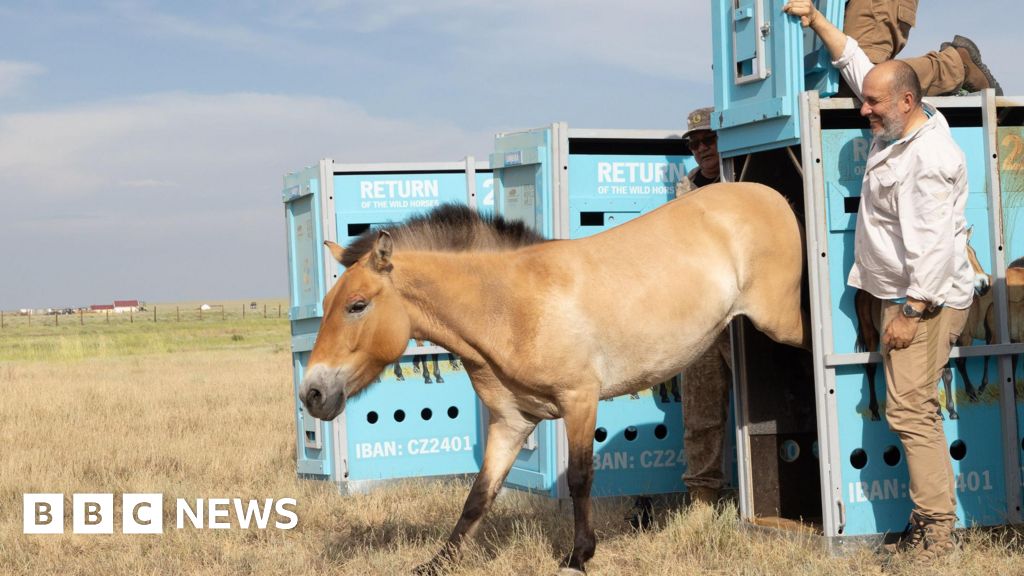World
Przewalski’s horses return to Kazakhstan steppes after 200 years – BBC News

Image source, Václav Šilha/Prague Zoo
- Author, Frances Mao
- Role, BBC News
Wild horses have returned to the Golden Steppe of Kazakhstan for the first time in at least 200 years after a decades-long reintroduction programme.
The 18-hour airlifts of seven Przewalski’s Horses from Europe to the Central Asian country took place across two operations in early June by the Prague Zoo.
The horses so far are doing well, roaming around the plains of their new environment, caretakers told the BBC. Their return to their ancestral homeland last week is a triumph of generations of conservation work, the zoo’s director, Miroslav Bobek, said.
“[The mare named] Tessa was the first to run out of the transport box into the pen, then Wespe, followed by Umbra, and Sary brought the foursome to a close,” he added.
The Przewalski’s horse is the last wild horse species on the planet, named after Russian explorer Nikolai Przewalski who was the first to identify the horse for the European science community.
The breed originated millennia ago from the steppes of Central Asia and was taken by researchers to Europe and North America in the 19th and 20th Centuries, where it founded larger populations.
Some of them ended up in zoos in Munich and Prague – it’s their descendants that have now been reintroduced in Kazakhstan.
Cultural artefacts show people in the region were riding and using the horses for food in northern Kazakhstan at least 2,000 years before the first records of domesticated horses in Europe.
But by the time Przewalski, a geographer, discovered them, the wild populations in Asia were already dying out. They were found only in a small section of western Mongolia.
“The seven horses that we transported here by two Czech Army planes represent the first individuals of this species in central Kazakhstan in hundreds of years,” Mr Bobek said.
The Prague Zoo was at the centre of international efforts to save the horses after World War Two, when they were entrusted with the “international studship” of the breed.
Przewalski’s horses have long been considered the main remaining true wild horse; species such as the American mustang and Australian brumby are feral horses descended from domesticated animals.
They are shorter and stockier than modern domesticated horses and their genetic differences show that neither species are ancestors of the other.
Prague Zoo, which has spent the past decade and a half introducing the horses back to Central Asia, mainly in Mongolia, said the Kazakhstan operations had been in the plans since 2022.
Last week saw the culmination of years of work. The six mares and one stallion were selected from different programmes around Europe and put together in the same zoo in Berlin – Tierpark Berlin – for several months to become acquainted before their journey.
That then kicked off in early June, with military airplanes flying the standing horses in two groups on a 6,000km-route that included stopovers in Turkey and Azerbaijan.
Once they touched ground at the Arkalyk Airport in Kazakhstan, they were taken on an eight-hour drive to the plains where they were then finally released onto the Altyn Dala – the Kazakh name for the Golden Steppe.
“Our goal is to slowly transport at least 40 individuals here, so that a viable population can be set up,” Mr Bobek said.
The mares were released in a different paddock to the first group containing the stallion to try and ensure genetic diversity.
“Ideally, in the future, they will form a harem with another stallion so that there will be more stallions breeding right from the start,” Mr Bobek said.
It had always been the zoo’s dream, he added, to release the horses back into their native lands: “Hardly anything could be a better demonstration of the purpose of modern zoos than the return of the Wild Horses.”







:max_bytes(150000):strip_icc()/roundup-writereditor-loved-deals-tout-f5de51f85de145b2b1eb99cdb7b6cb84.jpg)


